On the second day of reboot 7.0, I left my laptop at the hotel and took notes in my Moleskin notebook instead.
After being turned on to Flickr by Ben (yes, I know I should have paid attention earlier; it was just the whole “my photos on someone else’s server” thing that hung me up), and then seeing Olle’s demo of photo annotations, it dawned on me that I could scan my notes, upload to Flickr and annotate them with web links and additional explanatory text.
This Flickr set is the result. Click on any of the images, then “mouse over” the black annotation boxes to see the notes, and click on any hyperlinks you see in the notes to jump onwards.
I’m not sure that this is a sustainable habit: the scanning, cropping, uploading and annotating took a lot longer than simple transcription would have taken. But I do like having the original document visible, squiggles and all, for reference.
On this rainy late afternoon Saturday, I found myself sitting in the Formosa Tea House reading Almost French (subtitled “Love and a new life in Paris”), and this passage made me lust (yes, lust) for a cup of hot chocolate:
At Frédéric’s insistence we order hot chocolate — the speciality of the maison, he promises. It arrives in two steaming white jugs and you can tell just from the smell that this is an intense brew made with cream and couverture chocolate. We fill our cups. The liquid pours slowly like an oil slick of dark molten mousse.
The closest I have ever come to reaching this height of chocolate ecstasy was at Le Relais de la Tour in Capdenac le Haut; here is the evidence:
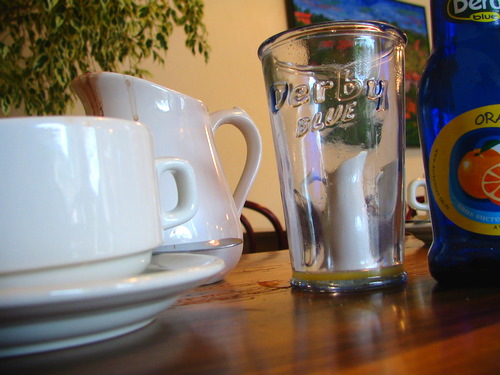
How did I choose to sate my lust today? Well, Timothy’s was closed, it was too rainy to head to Mavor’s, so I had to settle for Tim Hortons. Yes, I realize I am an idiot. I wanted a molten oil slick of pleasure and instead I got a soupy paper cup of tepid Quik. What was I thinking?
Couverture, just in case you were wondering, is “a term used for cocoa butter rich chocolates of the highest quality.” (thanks to Wikipedia for that).
This brings another episode of my Europhilia to a close. Sorry for the interruption.
Microsoft’s euro page is uncommonly concise and useful. Quick reference: in HTML, you can represent the euro currency symbol — the € — with €.
One of the people I met last week at reboot was Dragos, a smart Romanian who reminded me that there’s a lot of interesting stuff going on in that country. Indeed there was an uncommon (at least for me) amount of talk at reboot about Romania.
Here’s another thing (quote in the title of the post is from that story): the €5,000 automobile (the Dacia Logan).
Regular readers may recall that another Romanian product, PDFReports from Interakt was responsible for producing the official lists of electors in the 2003 Provincial General Election here (full story, with video in this talk I gave at Zap).
One last Plazes experiment for the day, built on the back of yesterday’s AppleScripting: an AppleScript to set your Adium status message to your current Plazes location.
Here’s how to paste the pieces together.
First, grab this AppleScript code and paste it into Script Editor. Change the values for your Plazes username and password, and save as an AppleScript application. Make sure you set the File Format to “Script,” as in the following screen shot:
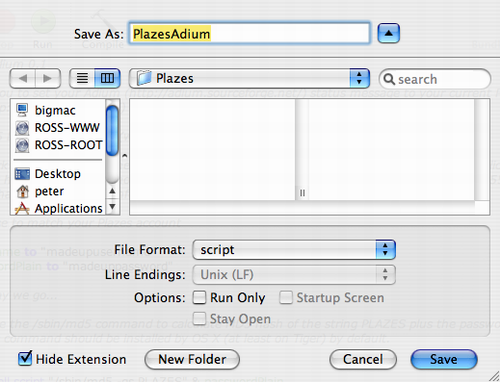
Next, in the Adium preferences, select Events, and double click on the “You Connect” event, select “Run an Applescript” as the Action, and select the AppleScript you just saved as the script:
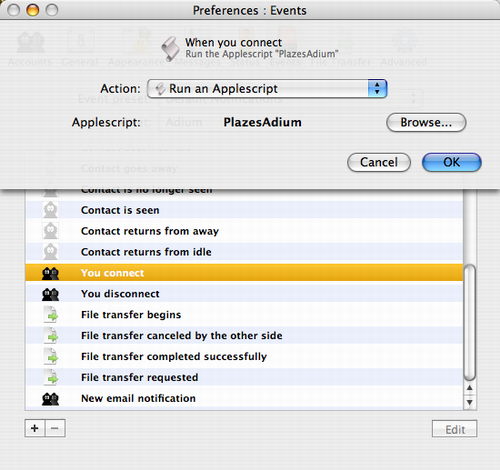
That’s it. Now every time you run Adium and connect, the AppleScript should run, connect to Plazes, get your current location, and set your status message:

The script assumes you’ve already run the Plazes launcher. I haven’t tested the code extensively. And thanks to Adium for having such wonderful AppleScript support! Comments welcome.
Thanks to some PHP rigor from Olle, I’ve updated the code example I threw together yesterday to allow access to your current Plazes location from PHP. This updated code doesn’t do anything new, it’s just better documented, and more standardly formatted.
Sometime this spring I passed the half million mark in the “words I’ve written on this blog” counter. That’s half a million words in six years. Some interesting statistics:
- Most popular proper nouns:
- Island (478 times)
- Oliver (452 times)
- Charlottetown (347 times)
- Catherine (334 times)
- Internet (312 times)
- CBC (258 times)
- Canada (231 times)
- Number of mentions of Aliant: 159
- Number of uses of word compelling: 60
- Number of uses of word nifty: 12
- Number of uses of word shit: 17
- Number of uses of word fuck: 9
- Number of uses of word love: 65
- Most prolific month: June, 2003 (22,787 words)
- Most prolific day: July 27, 2004 (4,018 words)
- Words written by year:
- 2005: 69,818 words
- 2004: 139,390 words
- 2003: 155,547 words
- 2002: 100,924 words
- 2001: 71,778 words
- 2000: 10,428 words
- 1999: 676 words
- Most popular links to other websites:
- Island Tel (58 links)Yankee (35 links)
- Air Canada (22 links)
- Steven Garrity (21 links)
- The Old Farmer’s Almanac (21 links)
- Zap Your PRAM (20 links)
- silverorange (19 links)
- Maritime Electric (13 links)
- ISN (12 links)
- Brackley Drive-in (12 links)
- Number of graphics and photos: 618
I received the following email today, presumably in response to this sort of search result:
What a shame that, when I typed in the name of the Charlottetown festival, I came up with your rant. Not very welcoming for us tourists… or our money.
Here’s how I replied:
Thank you for your note.
The web is a rich and diverse place; that’s what makes it so great.
It means that if a well-funded organization, like our Capital Commission, pours money into promoting and advertising an event that will take over our neighbourhood, “we the people” have an outlet to shout back.
In this light, I’m extremely happy that you found my blog post: it means the shouting back is working.
In terms of your tourism dollars: I’m curious to know why you don’t welcome the opportunity to learn more about how your dollars will impact the local community you choose to visit.
You are, of course, welcome to visit Charlottetown — we would love to have you (and your money). But *how* you visit is important: if you visit to support a rock festival that adversely affects our neighbourhood, then I would argue that your tourism might be doing more harm than good.
I think I have a *responsibility* to tell you that you might annoy me, and adversely affect the quality of life of my family and I, through your actions.
My correspondent replied (bless her heart):
All very true. And well said. Food for thought.
Next step in my Plazes experimenting: getting PHP to find out “where I am.”
Grab this PHP script, edit with the value of your Plazes username and password, and then run. The result will look something like this:
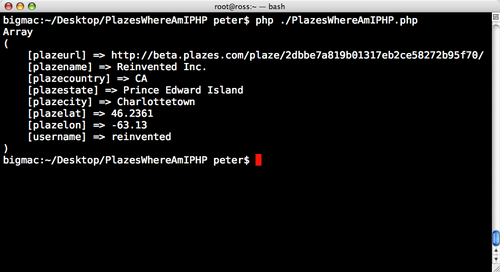
The script assumes the presence of XML-RPC for PHP, which is easy to grab and install. All the script does it to dump an array reflecting what’s returned, via XML-RPC, from the Plazes server, but the code should give you enough to go on to do many more interesting things.
Stefan sent me the API documentation for Plazes yesterday, and I’ve been fooling around with it today.
The first product of my experimenting is a demonstration of how to look up your current “plaze” from AppleScript.
To try this out for yourself, download AppleScript code, paste it into Script Editor, update with the values for your Plazes username and password and run. Assuming you’ve already run the Plazes Launcher, the result should be something like this:
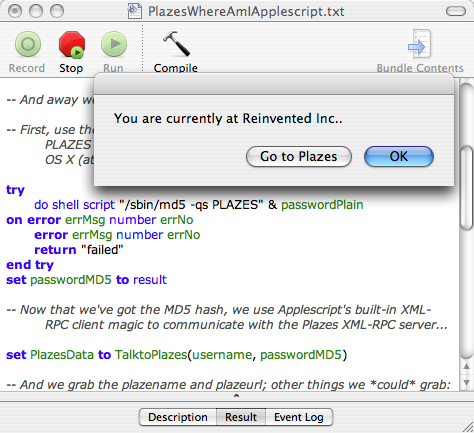
If you click on the “Go to Plazes” button, then your Safari should open to the Plazes page for your current location.
This isn’t intended to be a useful or complete application — and there should probably be more error checking — but it should be enough to get you started in Plazes development using AppleScript.
 I am
I am